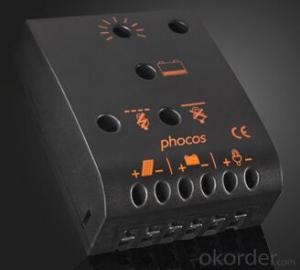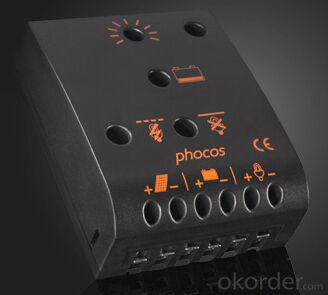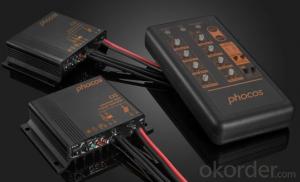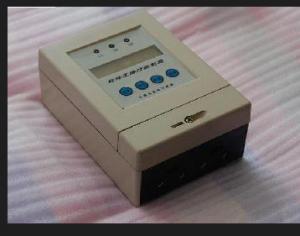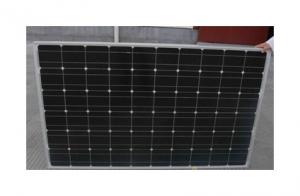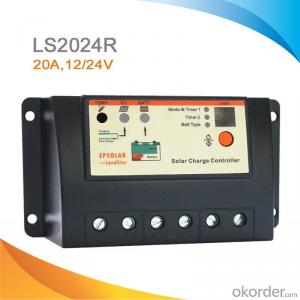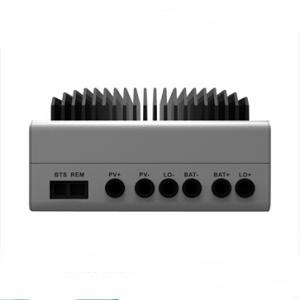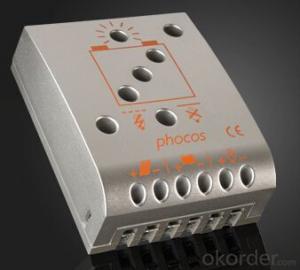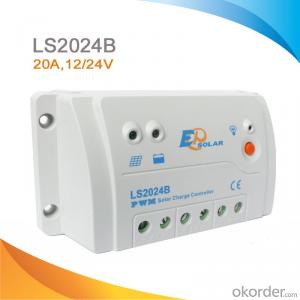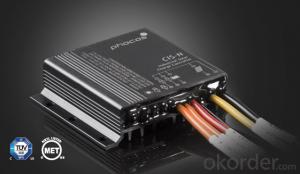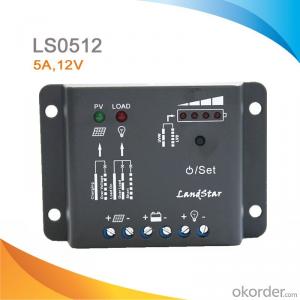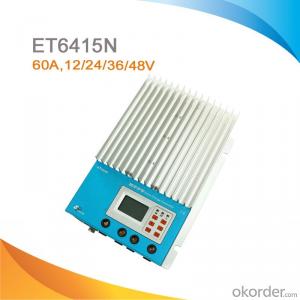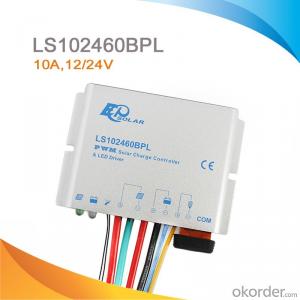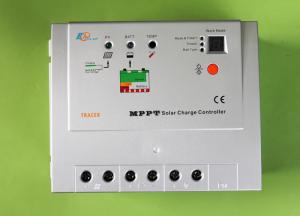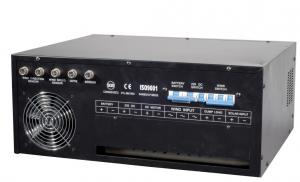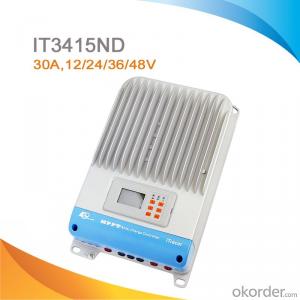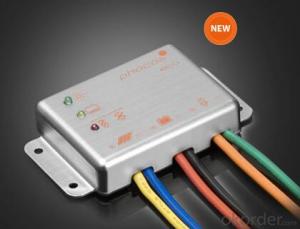12V CA Series (6-14A) Solar Charge Controller
- Loading Port:
- China Main Port
- Payment Terms:
- TT OR LC
- Min Order Qty:
- -
- Supply Capability:
- 10000 unit/month
OKorder Service Pledge
OKorder Financial Service
You Might Also Like
· Electronically regulated charging regime: Boost and float charge
· Deep discharge protection
· PWM series regulation, no panel short circuit
· Integrated temperature compensation
· Fully electronically protected:
·
Panel surge voltage
·
Wrong polarity at panel or battery
·
Overload and short circuit at load
· 3 LED indications: Charge Status, SOC, LVD, Overload! Short Circuit
· Common positive allows grounding
· The new version of CA solar charge controller series is especially designed for small solar systems with the need of a low battery disconnect feature.
· Main differences to the preceding CA series:
· The regulation circuit provides now series regulation to prevent single cell overheat problems of short-circuited solar panels. The terminal section has been replaced by a rugged, well profen 16 mm2 terminal block.
· The melting fuse of the predecessor has been replaced by a fully electronically protected circuit.
· 2 LEDs and 1 Duo-LED to display charging in progress, battery SOC, load disconnect and overload status. Leisure and rural electrification systems are the typical applications for this product. It is a perfect solution for cost-sensitive systems which require state-of-the-art system management.
· The compact case is now similar to the well-known CML series.
- Q: How does a solar controller prevent damage to the solar panels from overvoltage conditions?
- A solar controller prevents damage to the solar panels from overvoltage conditions by regulating the flow of electricity from the panels to the batteries. It monitors the voltage levels and ensures that they do not exceed the safe operating range of the panels. If the voltage exceeds the limit, the controller will automatically disconnect or reduce the flow of electricity to protect the panels from damage.
- Q: What is the maximum power rating a solar controller can handle?
- The maximum power rating a solar controller can handle depends on its specific design and specifications. However, in general, solar controllers are available in a wide range of power ratings, with some models capable of handling up to several hundred watts of solar power. It is important to carefully select a solar controller that is suitable for the specific solar panel configuration and power requirements of the system to ensure optimal performance and longevity.
- Q: What is the installation process for a solar controller?
- The installation process for a solar controller typically involves a few simple steps. Firstly, you need to mount the controller in a suitable location near the solar panels and battery bank. The controller should be placed where it is easily accessible for monitoring and maintenance. Next, you will need to connect the solar panels to the controller. This usually involves connecting the positive and negative wires from the solar panels to the corresponding terminals on the controller. After that, you will need to connect the battery bank to the controller. Similar to the solar panel connection, you will need to connect the positive and negative wires from the battery bank to the appropriate terminals on the controller. Finally, you will need to connect any additional components, such as inverters or load terminals, to the controller if required. It is crucial to follow the manufacturer's instructions and safety guidelines during the installation process. It is also recommended to consult with a professional or an electrician if you are unsure or unfamiliar with electrical installations.
- Q: Can a solar controller be used with solar panels that are connected to a battery backup system?
- Solar panels connected to a battery backup system can indeed utilize a solar controller. In fact, a solar controller is typically a crucial element of such a system. The primary role of a solar controller is to regulate the voltage and current from the solar panels to prevent battery overcharge. It achieves this by monitoring the battery's state of charge and adjusting the charging parameters accordingly. When solar panels are linked to a battery backup system, the solar controller ensures efficient and effective battery charging. It manages the electricity flow from the solar panels to the batteries, maximizing charging capacity and optimizing battery lifespan. Furthermore, a solar controller can provide other significant functions, including load control, which manages power consumption from the batteries, and system monitoring, which offers real-time information on solar panel and battery performance. In summary, a solar controller is an indispensable component in a solar panel system connected to a battery backup system. It guarantees proper battery charging and management, while enhancing overall system efficiency and performance.
- Q: Can a solar controller be used with solar panels that are connected to a micro-inverter?
- When solar panels are connected to a micro-inverter, it is possible to use a solar controller. The purpose of a solar controller is to regulate the charging of batteries in a solar power system. It manages the flow of electricity from the solar panels to the batteries, preventing overcharging and ensuring efficient charging. In a system where solar panels are connected to a micro-inverter, the micro-inverter converts the DC power generated by the solar panels into AC power. This AC power can be used by household appliances or sent back to the grid. The micro-inverter adjusts the output voltage and frequency of the AC power. Despite the presence of a micro-inverter, the solar controller can still be utilized to regulate battery charging. It monitors the current and voltage of the solar panels and adjusts the charging parameters accordingly. While the micro-inverter's role is limited to power conversion, the solar controller optimizes the charging process to ensure proper battery charging and protection. In summary, combining a solar controller and a micro-inverter enables efficient power conversion and optimal battery charging in a solar power system.
- Q: How do I install a solar controller in my solar panel system?
- Installing a solar controller in your solar panel system is a relatively straightforward process. Here are the steps to guide you through the installation: 1. Determine the appropriate location: Find a suitable location near your solar panels where you can mount the solar controller. The controller should be protected from direct sunlight, rain, and extreme temperatures. 2. Gather the necessary tools: You will need a screwdriver, wire strippers, electrical tape, and mounting brackets (if not included with the solar controller). 3. Disconnect the solar panels: Before beginning the installation, disconnect the solar panels from the battery and the charge controller, if already installed. 4. Mount the solar controller: Attach the mounting brackets to the solar controller, and then secure the brackets to a suitable surface near the solar panels. Ensure the controller is easily accessible for future maintenance. 5. Connect the battery: Identify the battery terminals on the solar controller and connect the positive (+) and negative (-) leads from the battery. Make sure to follow the proper polarity to avoid damage. 6. Connect the solar panels: Locate the solar panel terminals on the controller and connect the positive (+) and negative (-) leads from the solar panels. Again, ensure the correct polarity to prevent any issues. 7. Secure the connections: Use wire strippers to strip off a small section of insulation from the ends of the wires. Insert the stripped wires into the appropriate terminals on the solar controller and tighten the screws to secure the connections. Ensure all connections are tight and secure. 8. Check the connections: Once all connections are made, double-check that everything is properly connected and tightened. Inspect for any frayed or damaged wires and repair or replace them as necessary. 9. Test the system: Reconnect the solar panels to the charge controller and battery. Turn on the solar panel system and monitor the solar controller to ensure it is functioning correctly. Check for any error or warning messages and troubleshoot accordingly. 10. Perform regular maintenance: After installation, regularly inspect the solar controller for any issues, clean the solar panels, and check the wiring connections. This will help ensure optimal performance and extend the lifespan of your solar panel system. Remember, if you are unsure about any step or lack the necessary electrical knowledge, it's best to consult a professional electrician or solar installer for assistance.
- Q: Can a solar controller be used with a 48V battery bank?
- A 48V battery bank can indeed be used in conjunction with a solar controller. The main role of the solar controller is to regulate the electricity flow from the solar panels to the battery bank. Its primary functions are to efficiently charge the batteries and safeguard them against both overcharging and discharging. The majority of solar controllers are equipped with a wide voltage range capability, making them compatible with 48V battery banks. Therefore, as long as the solar controller is designed to handle the battery bank's voltage, it can effectively operate within a 48V system. Before installation, it is crucial to verify that the solar controller is compatible with the specific voltage of the battery bank in order to prevent any potential compatibility issues.
- Q: Can a solar controller be used with different types of solar charge controllers?
- No, a solar controller generally cannot be used with different types of solar charge controllers. Each type of solar charge controller is designed to work with a specific type of solar panel technology and voltage range. For example, there are different charge controllers for solar panels that use crystalline silicon, thin-film, or amorphous silicon technologies. Additionally, different charge controllers have different maximum voltage and current ratings. Therefore, it is important to choose a solar controller that is specifically compatible with the type of solar charge controller being used to ensure optimal performance and safety.
- Q: What is the maximum input voltage for a solar controller with an LCD display?
- The maximum input voltage for a solar controller with an LCD display typically depends on the specific model and manufacturer. However, it is common for solar controllers with LCD displays to have a maximum input voltage range of around 100-150 volts DC.
- Q: Are all solar controllers compatible with all types of batteries?
- No, not all solar controllers are compatible with all types of batteries. Solar controllers are designed to regulate the charging and discharging of batteries in a solar power system. Different types of batteries have different voltage and charging requirements, and as a result, solar controllers need to be matched with the specific type of battery being used. There are several types of batteries commonly used in solar power systems, such as lead-acid, lithium-ion, and gel batteries. Each of these batteries has a different voltage range for charging and discharging, as well as different requirements for temperature compensation and equalization. Therefore, solar controllers need to be specifically designed to cater to these different battery types. For example, a solar controller that is designed for lead-acid batteries may have different charging algorithms and voltage settings compared to a solar controller designed for lithium-ion batteries. Using the wrong type of solar controller with a battery can lead to inefficient charging, reduced battery life, and even damage to the battery. To ensure compatibility, it is important to carefully read the specifications and recommendations provided by the solar controller manufacturer. These specifications will typically outline the compatible battery types, voltage ranges, and other important details. It is always advisable to consult with a professional or the manufacturer if there are any doubts about compatibility between a solar controller and a specific type of battery.
Send your message to us
12V CA Series (6-14A) Solar Charge Controller
- Loading Port:
- China Main Port
- Payment Terms:
- TT OR LC
- Min Order Qty:
- -
- Supply Capability:
- 10000 unit/month
OKorder Service Pledge
OKorder Financial Service
Similar products
Hot products
Hot Searches
Related keywords
